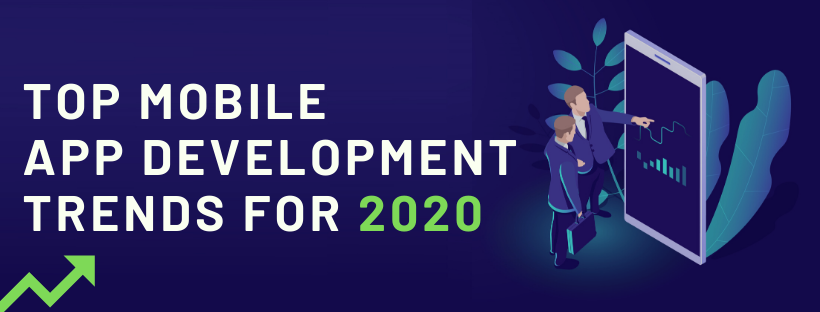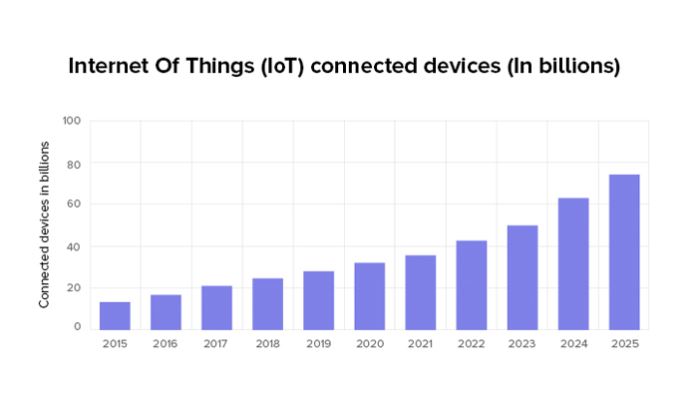
In the past few years, we have witnessed businesses go through some major transformations. The firms worldwide are conforming to the widespread effect of mobile technology and advancement. As per the experts, the mobile app industry is one of the leading sectors and is growing at a swift pace. According to statista, by the year 2023, mobile apps are expected to generate more than 900 billion U.S dollars via paid downloads and in-app advertising.
But the implementation of the right mobile app development strategies is not enough, you need to integrate the latest mobile application trends as well. And to achieve the same, you need to have a team of proficient and mobile app development expertise.
So here are the top mobile app technology trends that are going to rule 2020 and you should pay attention to it.
Top 10 Mobile App Trends For 2020
1. Beacon Technology
2. 5G Generation
3. Wearables
4. Artificial Intelligence
5. Blockchain Technology
6. Internet Of Things
7. Mobile Wallets
8. AR/VR
9. Cloud Integration
10. On-Demand Apps
1. Beacon Technology
The beacon technology-enabled app on the smart device shows the current picture, from where you need to buy the products, their costs, and other related specifications. There are many industries that are leveraging beacon technology like museums, healthcare, hotels, etc. Beacons are of great use and the latest development in location technology as well as in proximity marketing. Moreover, the technology is easy to use, which makes it more accessible and quickly adaptable.
The small and wireless Bluetooth transmitters utilize BLE (Bluetooth low energy) signals. As when your smart device enters the beacon-enabled zone, the app gets the signals instantly and notifies instantly to the users. They connect and transmit information to smartphones and makes the location-based searching and interaction more straightforward. For instance, beacons, combined with IoT, are used in the retail sector. Some of the future trends for beacon technology in 2020 are as follows like Mobile payments beacons, AI-enabled chips, Automated machine learning, Beacon treasure hunting, etc.
2. 5G Generation
With the advent of the 5th generation wireless cellular network by the year 2020, it has become possible to transmit millions of MB of data from the systems to the globally connected devices in the blink of an eye. As reported by IHS Economics, the wireless network is expected to contribute $12.3 trillion global economic output by the year 2035. The statistics provide the mobile app developers a clear insight into the bright future of 5G, encouraging them to prepare their existing app to win the 5G race. However, the current standard of the 5G network strictly depends upon the existing LTE 4G infrastructure, and speed isn’t the only thing that makes the 5G better than 4G. It also offers some notable benefits like low to zero latency, increased connection density, improved precision, improved battery life, and more. The applications of 5G service also cater to other functionalities such as Data Security, Speed, 3D Gaming, Augmented Reality and More.
3. Wearables
The wearable devices are making huge waves among its users. Some instances for wearable devices are; smartwatches, fitness bands, trackers, sports watches, smart jewelry, smart clothing, etc. And it is surprising to see how these wearables have changed and transformed the way people interact with intelligent devices. This technology is incorporated within the devices that are comfortably worn on bodies and can track the information on a real-time basis. For instance, they can track and analyze body movements, heartbeats, steps, body temperature, etc.
However, wearable technology does have some limits, like if you need to make the app function with any wearable device, it is supposed to be kept close to the smartphone. Some of the future trends of Wearables technology are Mind reading glasses, Virtual assistants in contact lenses, Smart shirts, buttons, pants, shoes and more.
4. Artificial Intelligence

A wide-ranging branch of computer science, that is concerned with building smart machines that have the ability to perform the tasks that require typical human intelligence. Or put simply, AI technology works on the simple definition, “build machines that are intelligent.” If we ask you what you exactly know about artificial intelligence, You would probably mention some virtual assistance, for instance, Siri, Google assistants, Chatbots, etc. Or something like AI-based photo filtering apps like Face App, Prisma, etc. But artificial intelligence has a brighter future in the year 2020. Besides the existing applications, many other tools such as AI-based cameras, voice translations, and more would find a new home in smart devices. AI-enabled smart devices to save a lot of time, effort, and money for mobile app development companies.
And in the year 2020, we’ll get to see a more active role of Artificial Intelligence. With expected revenue of over 8 billion U.S. dollars, static image recognition, classification, and tagging are forecast to lead the way, followed by algorithmic trading strategy performance Improvement and efficient, scalable processing of patient data.
5. Blockchain Technology
From the day of its introduction, Blockchain has been a game-changer, we can witness this in its offerings in the forms of cryptocurrencies as well as smart contracts. Blockchain is undoubtedly one of the best revolutionary technologies in the current scenario. As technology has helped many businesses and organizations to build their blockchain-powered apps, blockchain-based software solutions, and much more. The technology offers the best in class security for all the sensitive data. In simple words, a much-hyped distributed ledger technology has the potential to remove vast amounts of record-keeping, as well as streamline supply chains in ways not seen since the arrival of the internet. The technology is even used to create decentralized apps.
Also, the decentralized apps are those who have no owner, and neither we can shut it down, nor it has any downtime. Therefore, technology has become more useful and powerful than we can even imagine. Blockchain is contributing to the mobile application industry by making mobile apps itself decentralized.
6. Internet Of Things
According to the experts, the IoT has become a significant sector and is leading the mobile application development trend in the year 2020. And why not? The technology is nothing short of being revolutionary; for instance, its application on sensors and devices to web and B2B apps, IoT displays its full potential of being a smart technology. Some of its potentials include its Integration with cloud technology, making the app development more systemized. The technology has also helped people to control the non-IT equipment via remote control or mobile applications. Moreover, IoT is showing plenty of signs of continuous growth by becoming an essential part of the user’s life.
As per statista, the total installed base of the internet of things enabled devices is expected to amount to 75.44 billion worldwide by the year 2025.

7. Mobile Wallets
Mobile Wallet, which is also known as Mobile Money Transfer, is basically a technique that is gaining attention every day. Nowadays, mobile wallet trends are growing at a very fast pace. In other words, it is a digital technology that enables you to pay your bills online irrespective of the place and time, without having to pay via cash, credit or debit cards. It has made the payment process easier and way faster. Nowadays, even the business-consumer relationships have become digital. From e-commerce platforms to Fintech sectors, businesses and organizations are leveraging the benefits of mobile wallets. Many companies have transformed the way they operate to meet the ever-changing requirements of their clients. Using smartphones, tablets, and smartwatches, the companies and users are adopting offline and online transactions with mobile wallets. A mobile wallet stores credit cards, debit cards, coupons, or reward card information.
So in the year 2020, we will witness how mobile wallets that offer the highest level of secured encryption, is going to become the mainstream in all kinds of mobile applications.
8. AR/VR
The AR and VR are undoubtedly cool, and the AR/VR era has just started. But in the year 2020, the uses would not be only limited to gaming applications anymore. Many tech giants are already researching and innovating the use cases for both the technologies. In the last couple of years, we have witnessed the emergence of some obsessive gaming trends as well. The AR and VR basically link the physical world with the digital (virtual) world. Apple’s ARKit and Google’s ARcore are examples of the inevitable AR and VR technologies.
They provide us with many features like motion tracking, people occlusion, environmental understanding, and light estimation in their packages. So we surely are going to witness more than this. AR-based app ideas would probably turn into fully functional mobile apps, and it would be immensely beneficial, especially for sectors like healthcare, tourism, education, retail, marketing, etc.
9. Cloud Integration
Cloud integration is the most reliable platform to store and access the data, into the seamless and the faster way. In this growing and relatively new competition to native mobile app development, the cloud-based apps promise a lot. Cloud technology has never failed to amaze us with its endless benefits and possibilities.
The technology combines different cloud-based systems into an integral whole. The drivers of this activity are many. For instance, the cloud-integrated computing systems basically enables the enterprises to use a wide assortment of highly scalable resources on demand rather than building them and maintaining them in-house, some businesses are looking forward to use integrated resources in order to support their real-time applications, while others are eyeing the increased and growing automation capabilities for back-office and customer-facing platforms. Cloud integration also offers excellent support for mobile applications and provides easier and faster deployment, cost-savings and scalability options to the users. Small wonder, the cloud integration platforms are gaining popularity.
10. On-Demand Apps
Since smartphones have become a necessity, they fulfill all our demands through mobile applications. Users used to have more specific and location-based requirements and they didn’t have apps that could fulfill all their needs. Here the on-demand apps come to the rescue. All you have to do is just place your request, and you will get the services at your desired location. This is the beauty of on-demand applications. These apps are sitting inside your pocket to cater to your needs and desires within minutes.
Additionally, the on-demand economy is the result of those technology companies and organizations that thrive on consumer demand by offering them goods and services.
Conclusion
It would be definitely fascinating to see what the future holds for mobile app development. However, developing an app has become much more comfortable than ever. With the arrival of all these mobile application trends, everything is going to be a hundred times better, smoother, faster, and way simpler in 2020.
Moreover, the Integration of these trends into our phones is a big leap. You need to have a trusted mobile app development company to pursue the same. And in that regard, Matellio is the best choice. Get in touch with us today!!



